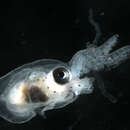en
names in breadcrumbs


Male and small female Tremoctopus violaceus use Portugese Man-of-War (Physalia) tentacles for defense and possibly to help capture prey (see Behaviour section).
A remarkable method of defense has been documented for Tremoctopus violaceus. Jones (1963) noted that earlier reports had documented the occurrence of unidentified cnidarian tentacles on the arms of immature T. violaceus, and the suggestion had been made that this might be a defensive strategy, with the octopus actively acquiring these tentacles as weapons rather than just the result of a chance encounter. Subsequent observations by Jones revealed that these tentacles were from the Portugese Man-of-War (Physalia) and were attached in an orderly fashion to each row of suckers on each of its four dorsal arms, with none found on the four ventral arms. Jones noted anatomical features of the suckers that he proposed are adaptaions for holding cnidarian tentacles (see Jones 1963). Jones speculated that these weapons might also be used to aid in capturing prey.
Only the tiny males and females 7 cm or less in length have been observed carrying tentacles. Norman et al. (2002) speculate that males of this species may be so small in part because the evolutionary benefits of larger size cannot compensate for the loss of this effective weapon system. The fecundity benefit for females that comes with larger size, in contrast, might be sufficient to compensate for outgrowing the "tentacle weapon system". Reproductive competition among males may also drive the reduced size of males. Females have been found with multiple male arms in their mantle cavities (Thomas 1977), suggesting the possible importance of competition among males for fertilization opportunities. Maturing at a small size might allow earlier and greater investment in sperm than would otherwise be possible.
The blanket octopus (Tremoctopus violaceus) is a rarely encountered pelagic species that spends its entire life cycle in the open ocean (Norman et al. 2002). Until the first observation of a living male off the northern Great Barrier Reef, Australia (Norman et al. 2002), males were known only from dead individuals picked up in trawls and plankton nets. Like other pelagic octopus species, T. violaceus exhibits sexual size dimorphism. The degree of sexual size dimorphism in this species, however, is extraordinary: Females may reach 2 m in length whereas the reproductively mature male collected by Norman et al. was just 2.4 cm long. Individual weights of males and females differ by a factor of at least 10,000 (Norman et al. 2002).
Additional information and images are available on the Tremoctopus genus page.
Widely distributed in tropical and subtropical waters of all oceans.
Tremoctopus violaceus violaceus is found in the Atlantic and T. v. gracilis in the Indo-Pacific. Some authorities treat these two forms as distinct species.
Epipelagic (i.e., occurs in the surface zone, where sufficient light penetrates to support photosynthesis).
In a study of the diets of two billfish, the Mediterranean spearfish (Tetrapturus belone) and the swordfish (Xiphias gladius), in the central Mediterranean Sea, Romeo et al. (2009) reported that Tremoctopus violaceus was present in the diets of both fish.
Norman et al. (2002) provide a description of reproductive behavior in this species: Mature male T. violaceus develop a large modified reproductive arm (hectocotylus) within a spherical pouch. When males mate, this pouch ruptures, sperm is injected into the tip of the modified arm, and the arm is severed and transferred to the female. The male presumably dies. Regenerating hectocotylised arms have never been found among the many dead males that have been captured in trawls. In benthic arm-dropping octopuses, arm regeneration takes about 6-8 weeks (Ward pers. comm. cited in Norman et al. 2002). If male T. violaceus mated more than once, regenerating males would likely have been encountered. The detached arm remains in the female's mantle cavity until it is used to fertilize her eggs (Thomas 1977).
Potential fecundity of T. violaceus violaceus (the Atlantic subspecies) was estimated by Laptikhovsky and Salman (2003) to be about 100,000-300,000, depending on female size, with eggs released in batches of 10,000-30,000 (first and last batches smaller). Laptikhovsky and Salman report that the spawning period lasts 0.5-1 month, with most eggs produced during the first one to two weeks. They also note that in both mature female T. violaceus they examined, only the left oviduct was found to be functional and to contain ripe eggs.
Tremoctopus violaceus violaceus is found in the Atlantic and T. v. gracilis in the Indo-Pacific. Based on differences in the structure of the modified male reproductive arm, it is likely that these two forms are actually distinct species (Michael Vecchione, pers. comm., Dec. 2009).